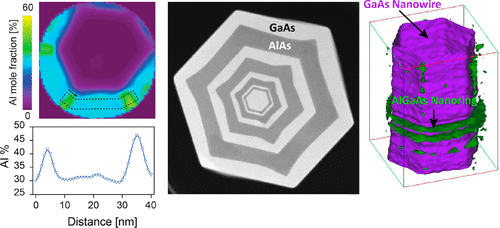当前位置:
X-MOL 学术
›
Nano Lett.
›
论文详情
Our official English website, www.x-mol.net, welcomes your
feedback! (Note: you will need to create a separate account there.)
Connecting Composition-Driven Faceting with Facet-Driven Composition Modulation in GaAs–AlGaAs Core–Shell Nanowires
Nano Letters ( IF 9.6 ) Pub Date : 2018-07-11 00:00:00 , DOI: 10.1021/acs.nanolett.8b02104 Nari Jeon 1 , Daniel Ruhstorfer 2 , Markus Döblinger 3 , Sonja Matich 2 , Bernhard Loitsch 2 , Gregor Koblmüller 2 , Lincoln Lauhon 1
Nano Letters ( IF 9.6 ) Pub Date : 2018-07-11 00:00:00 , DOI: 10.1021/acs.nanolett.8b02104 Nari Jeon 1 , Daniel Ruhstorfer 2 , Markus Döblinger 3 , Sonja Matich 2 , Bernhard Loitsch 2 , Gregor Koblmüller 2 , Lincoln Lauhon 1
Affiliation

|
Ternary III–V alloys of tunable bandgap are a foundation for engineering advanced optoelectronic devices based on quantum-confined structures including quantum wells, nanowires, and dots. In this context, core–shell nanowires provide useful geometric degrees of freedom in heterostructure design, but alloy segregation is frequently observed in epitaxial shells even in the absence of interface strain. High-resolution scanning transmission electron microscopy and laser-assisted atom probe tomography were used to investigate the driving forces of segregation in nonplanar GaAs–AlGaAs core–shell nanowires. Growth-temperature-dependent studies of Al-rich regions growing on radial {112} nanofacets suggest that facet-dependent bonding preferences drive the enrichment, rather than kinetically limited diffusion. Observations of the distinct interface faceting when pure AlAs is grown on GaAs confirm the preferential bonding of Al on {112} facets over {110} facets, explaining the decomposition behavior. Furthermore, three-dimensional composition profiles generated by atom probe tomography reveal the presence of Al-rich nanorings perpendicular to the growth direction; correlated electron microscopy shows that short zincblende insertions in a nanowire segment with predominantly wurtzite structure are enriched in Al, demonstrating that crystal phase engineering can be used to modulate composition. The findings suggest strategies to limit alloy decomposition and promote new geometries of quantum confined structures.
中文翻译:

GaAs-AlGaAs核-壳纳米线中的成分驱动刻面与成分驱动刻面调制的连接
可调节带隙的三元III–V合金是工程制造基于量子受限结构(包括量子阱,纳米线和点)的先进光电器件的基础。在这种情况下,核-壳纳米线在异质结构设计中提供了有用的几何自由度,但是即使在没有界面应变的情况下,在外延壳中也经常观察到合金偏析。高分辨率扫描透射电子显微镜和激光辅助原子探针层析成像技术用于研究非平面GaAs-AlGaAs核-壳纳米线中偏析的驱动力。对生长在径向{112}纳米面上的富Al区的生长温度依赖性研究表明,取决于面的键合偏好驱动了富集,而不是动力学上受限制的扩散。当在GaAs上生长纯AlAs时,观察到明显的界面刻面,证实了{112}面上的Al优先于{110}面上的键,从而解释了分解行为。此外,原子探针层析成像产生的三维成分分布图揭示了垂直于生长方向的富铝纳米环的存在。相关的电子显微镜显示,在主要具有纤锌矿结构的纳米线段中,短的锌闪锌矿插入物富含Al,表明晶相工程可用于调节成分。这些发现提出了限制合金分解并促进量子约束结构新几何形状的策略。此外,原子探针层析成像产生的三维成分分布图揭示了垂直于生长方向的富铝纳米环的存在。相关的电子显微镜显示,在主要具有纤锌矿结构的纳米线段中,短的锌闪锌矿插入物富含Al,表明晶相工程可用于调节成分。这些发现提出了限制合金分解并促进量子约束结构新几何形状的策略。此外,原子探针层析成像产生的三维成分分布图揭示了垂直于生长方向的富铝纳米环的存在。相关的电子显微镜显示,在主要具有纤锌矿结构的纳米线段中,短的锌闪锌矿插入物富含Al,表明晶相工程可用于调节成分。这些发现提出了限制合金分解并促进量子约束结构新几何形状的策略。证明晶相工程可用于调节组成。这些发现提出了限制合金分解并促进量子约束结构新几何形状的策略。证明晶相工程可用于调节组成。这些发现提出了限制合金分解并促进量子约束结构新几何形状的策略。
更新日期:2018-07-11
中文翻译:

GaAs-AlGaAs核-壳纳米线中的成分驱动刻面与成分驱动刻面调制的连接
可调节带隙的三元III–V合金是工程制造基于量子受限结构(包括量子阱,纳米线和点)的先进光电器件的基础。在这种情况下,核-壳纳米线在异质结构设计中提供了有用的几何自由度,但是即使在没有界面应变的情况下,在外延壳中也经常观察到合金偏析。高分辨率扫描透射电子显微镜和激光辅助原子探针层析成像技术用于研究非平面GaAs-AlGaAs核-壳纳米线中偏析的驱动力。对生长在径向{112}纳米面上的富Al区的生长温度依赖性研究表明,取决于面的键合偏好驱动了富集,而不是动力学上受限制的扩散。当在GaAs上生长纯AlAs时,观察到明显的界面刻面,证实了{112}面上的Al优先于{110}面上的键,从而解释了分解行为。此外,原子探针层析成像产生的三维成分分布图揭示了垂直于生长方向的富铝纳米环的存在。相关的电子显微镜显示,在主要具有纤锌矿结构的纳米线段中,短的锌闪锌矿插入物富含Al,表明晶相工程可用于调节成分。这些发现提出了限制合金分解并促进量子约束结构新几何形状的策略。此外,原子探针层析成像产生的三维成分分布图揭示了垂直于生长方向的富铝纳米环的存在。相关的电子显微镜显示,在主要具有纤锌矿结构的纳米线段中,短的锌闪锌矿插入物富含Al,表明晶相工程可用于调节成分。这些发现提出了限制合金分解并促进量子约束结构新几何形状的策略。此外,原子探针层析成像产生的三维成分分布图揭示了垂直于生长方向的富铝纳米环的存在。相关的电子显微镜显示,在主要具有纤锌矿结构的纳米线段中,短的锌闪锌矿插入物富含Al,表明晶相工程可用于调节成分。这些发现提出了限制合金分解并促进量子约束结构新几何形状的策略。证明晶相工程可用于调节组成。这些发现提出了限制合金分解并促进量子约束结构新几何形状的策略。证明晶相工程可用于调节组成。这些发现提出了限制合金分解并促进量子约束结构新几何形状的策略。










































 京公网安备 11010802027423号
京公网安备 11010802027423号